| | Introduction | Issue of sodium/salt in Canadian diet | Major food group contributors to sodium intake | Health effects of sodium/salt | Some findings from a large national survey in Canada | Do you know that
.
Introduction
This edition of consumer corner is based on the ‘Sodium Reduction Strategy for Canada’ report. The report was prepared by the Multi-Stakeholder Working Group of Sodium Reduction (also referred to as Sodium Working Group). In 2007, Minister of Health established Sodium Working Group to develop and oversee the implementation of a population health strategy for reducing sodium intake among Canadians. The Strategy has an interim sodium intake goal of a population average of 2300 mg of sodium per day to be achieved by 2016. The ultimate goal is to lower sodium intakes to a population mean whereby as many individuals as possible (greater than 95%) have a daily intake below the Tolerable Upper Intake Level (UL) of 2,300 mg per day.

Issue of Sodium/Salt in Canadian Diet
High sodium/salt intake is a global problem. As a result of high sodium/salt intake around the world, in 2003, the World Health Organization (WHO) set a worldwide target of 5g or less salt per day per person (less than 2000mg).
The current mean intake of sodium/salt by Canadian is about 3400 mg per day (Statistic Canada 2004).
Canadian Community Health Survey (2004) indicate that among people aged 9 to 70 years, over 85% of men and between 63% and 83% of women had sodium/salt intake exceeding the tolerable Upper Intake of 2300 mg.
Similarly, in young children, 77% of those aged 1 to 3 years and 93% of those aged 4 to 8 years had salt intakes that exceeding the Tolerable Upper Intake level.
Major Food Group Contributors to Sodium Intake
- 77% of sodium/salt intake from commercially processed foods. Commercially prepared food includes those from restaurants and food services establishments.
- 12% of sodium/salt is naturally occurring
- 5% is added during cooking
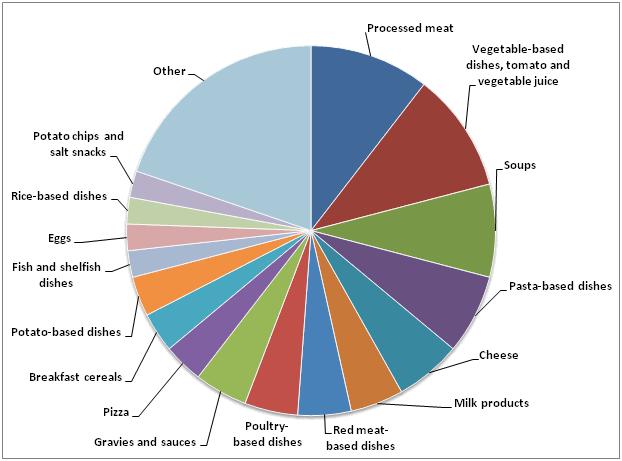
Health Effects of Sodium/Salt
- Sodium/salt is an essential element that required in small amounts for the normal functioning of the body
- Excessive amounts of sodium/salt have been shown to cause high blood pressure
- The World Health Organization (WHO) has estimated that high blood pressure is the leading preventable risk factor for death in the world.
- In Canada 19% of adults (20-79 years) have hypertension and another 20% is classified as pre-hypertension
- Hypertension is a major cause of cardiovascular disease, which is the number one cause of death in Canada
According to a US study (2010), even modest reduction of 1g of salt (440mg)/day (average sodium/salt intake) would results:
- Coronary heart disease down by between 60,000 and 120,000 cases annually
- Stroke down by between 32,000 and 66,000 cases annually
- Myocardial infractions down by between 54,000 and 99,000 cases annually
- Death from all sources down by between 44,000 and 92,000 annually
- Savings in health care costs would range from $10 to $24 billion annually
Some Findings from a Large National Survey in Canada
- Are Canadians knowledgeable about sodium/salt?
- Very few Canadians understand what a healthy amount of sodium/salt is
- What Canadians think about their own sodium/salt consumption and others’ sodium/salt consumption?
Canadians are aware that the population consumption of sodium/salt is high, but believe that they, personally, are doing well compared to others
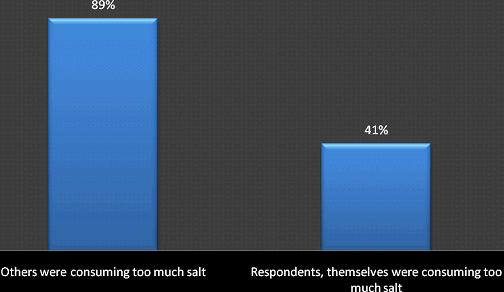
- Canadians’ level of concern about sodium/salt
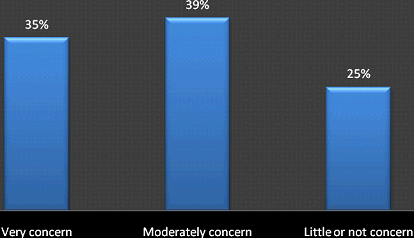
- What steps are being taken by Canadians to control sodium/salt intake?
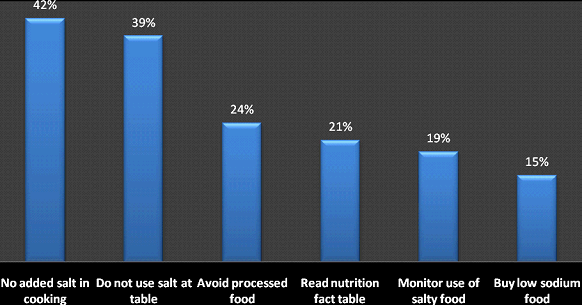
- What Canadians are doing to improve eating?
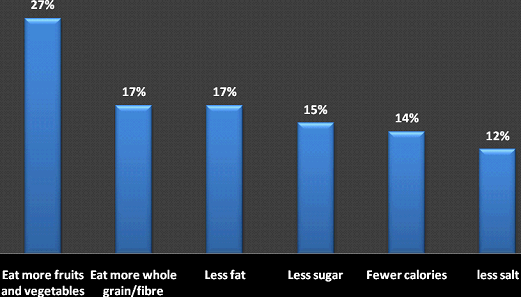
Do You Know That ……..
- Blood Pressure Canada (now Hypertension Canada) has established a website- www.lowersodium.ca which provides guidance on sodium reduction to both the general public and to health professionals.
- The Canadian Stroke Network has established a website- http://www.sodium101.ca/ to inform consumers about the high sodium content of the Canadian food supply, along with a description of health impacts, adequate intake levels and tips on reducing intake.
- The Centre for Science in the Public Interest publishes monthly food product comparisons that consider the amount of sodium and other nutrients.
- The Heart and Stroke Foundation of Canada issued recommendations for Canadian consumers. The Heart and Stroke Foundation’s Health Check program is working directly with the food industry to lower the amount of sodium in the food supply.
- The Canadian food industry is also engaged in sodium reduction efforts.
|
|